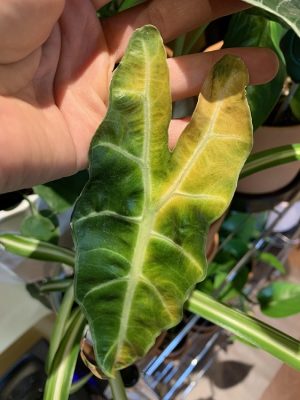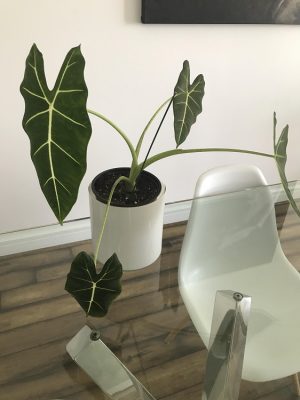Plant Care
Everything You Need to Know About Alocasia Plants
Alocasia Plant: Growing and Caring for Alocasia
Alocasia plant is a tropical plant that features a stunning leaves in arrow-head shape. Some plants are small while some can grow up to 8 or 10 feet tall, depending on care.

What Is an Alocasia Plant?
Fanily Name: Araceae
Botanical Name: Alocasia sanderiana
Plant Description:
Alocasia Plant is known for having leaves that resemble the shape of an arrow. Its dark, shiny leaves and long stems love the tropical weather.
This tropical plant is native to the regions in the South Pacific Islands, like Philippines. It prefers a place where the humidity level is higher.
How to Grow and Care for Alocasia Plant?
To grow and care for your Alocasia Plant at home, make use of this guide. It includes instructions about proper lighting, humidity, temperature, watering, and care of the plant during drought season and pest infestation.
Alocasia Polly
· LIGHT
Alocasia Polly prefers bright and indirect light, as well as filtered light, but not direct sunlight. If placed under full sun exposure, the leaves will suffer from sunburn. However, it may not thrive well in dark corners.
· WATER
Alocasia Polly prefers moist soil but not wet and damp. It means that regular watering is required, especially if it is kept indoors. This type of tropical plant is not capable of thriving in drought condition, but it can tolerate dryness once in a while. Too much water on the soil will rot the root, but too much dryness, on the other hand, may cause the tip of its leaves to turn brown.
· HUMIDITY
Alocasia Polly prefers high to medium humidity level. If it is placed in a spot with low humidity level, you can increase the humidity by misting on the plant regularly or by adding a pebble tray. A frequent shower on lukewarm water benefits the plant, too. For best results, keep the plant inside the bathroom or kitchen where humidity is higher.
· TEMPERATURE
Alocasia Polly prefers warm temperature, similar to the tropical environment. It does not thrive in indoor spaces where temperature is lower than 60 degrees and in places where temperature changes.
· FOOD
Alocasia Polly needs plant food at least once a month on spring and summer season, but not during the winter season. The fertilizer should be applied on damp soil and not on dry soil because it will burn the roots easily.
· TOXICITY
Alocasia Polly contains mild toxicity level that may cause vomiting and stomach or mouth irritation when ingested by pets or humans.
· ADDITIONAL CARE
Alocasia Polly needs additional care in the winter months while it is in dormancy stage. It prefers a warmer place while dormant. Water is required but on lesser amount only to protect the plant from drought.
Common Problems in Caring for Alocasia Polly
Why the leaves of Alocasia Polly turn yellow?
Why the leaves of Alocasia Polly become limp and droopy?
Why the leaves of Alocasia Polly turn yellow?
There are several reasons why the leaves turn yellow. Here are the possible causes and some tips on how to fix the problem:
· Moisture
The leaves of the Alocasia Polly turn yellow easily when the soil is left sitting in too much water. The moisture in the soil brought by overwatering causes the roots to rot. Although the plant loves a little dampness on the soil, it still wants a well-drained soil.
To prevent the leaves from turning yellow, the plant requires regular watering but on well-drained soil. The water should flow freely on the pot through its drainage hole to prevent soaking its roots in the water. If excess water sits in the saucer, remove the water immediately to prevent wet feet. Once you see the tip or edge of the leaves turning into yellow or brown color, it means that the roots are starting to rot.
In caring for the Alocasia Polly plant, it is important to provide them proper soil moisture. It is a type of plant that does not tolerate drought or extreme dryness. However, it will also cause stress on the plant if watering is done inconsistently.
· Humidity
Alocasia Polly prefers a humid place. One reason why its leaves turn yellow or brown is because the soil is too dry. To provide the humidity that the plant needs, you can use a humidifier or a misting spray or add a pebble tray near the pot.
· Light
Alocasia Polly prefers medium to bright light and indirect sunlight. The leaves become yellow or brown when exposed under direct sunlight. However, low and medium light may cause the plant to grow slowly. Too low light, on the other hand, may also cause the leaves to become yellow and weak.
· Pests
Alocasia Polly becomes an ideal target for pests when it is stressed or weak. Pests such as sap-sucking bugs, spider mites, and scale can easily infest the plant and suck its moisture if the plant is not healthy. When pests infest the plant, you will notice yellow leaves and fronds. Other pests, like mealy bugs and insects also see the Alocasia Polly as the perfect nesting ground, especially if the plant is placed indoors. The best way to treat pest infestation and diseases is to remove the bugs and pests away from the plant’s leaves and stems.
· Yellow Leaves are Natural
The leaves of the Alocasia Polly become yellow in color when they reach maturity. This happens when the plant grows new growth at the bottom. The plant naturally sheds off matured, yellow leaves when new growth begins to appear.
Why the leaves of Alocasia Polly are growing limp and drooping?
When the Alocasia Polly plant suddenly becomes limp and the leaves begin drooping, it is because of several reasons. It is normal for the plant’s leaves to become limp and drooping, and there are ways to fix the problem.
· The soil is dry
When the soil is dry, the Alocasia Polly plant gives the signal. The leaves are limp and droop, and eventually turn brownish in color. The plant wants its soil to be moist but not wet.
To treat or fix this problem, you can give the Alocasia Polly plant a thorough soak in water. It is also beneficial to the plant if you will water it consistently to provide moisture and prevent the soil from drying.
How to soak the Alocasia Polly plant in water?
Follow this instruction:
- With a tub, basin, or sink that is half-filled with water, place the Alocasia Polly plant to soak. You can use tap water or filtered water, but not hot water.
- Leave the potted Alocasia Polly plant in the tub or basin for at least 45 minutes to soak the dry soil.
- After 45 minutes, check if the soil has already absorbed the moisture or the water already reached up to 2-3 inches from the top.
- In case the soil is not saturated with moist, you can help the plant by watering the soil from the top.
- Once the soil is watered, leave the plant on the draining sink or basin to rest for a while. It allows the plant to hydrate well.
· The Humidity is Low
When the humidity level is low, the Alocasia Polly plant goes limp and droops. As a tropical, it thrives well in environments with higher humidity. To fix this problem, you may want to add a pebble tray in the area or a humidifier.
· The Light is Low
When the light is too low, the Alocasia Polly plant goes limp and droops. As a tropical plant, it loves the brightness from the sun or from artificial light. It may also thrive well under direct sunlight exposure but only for a little while every day.
